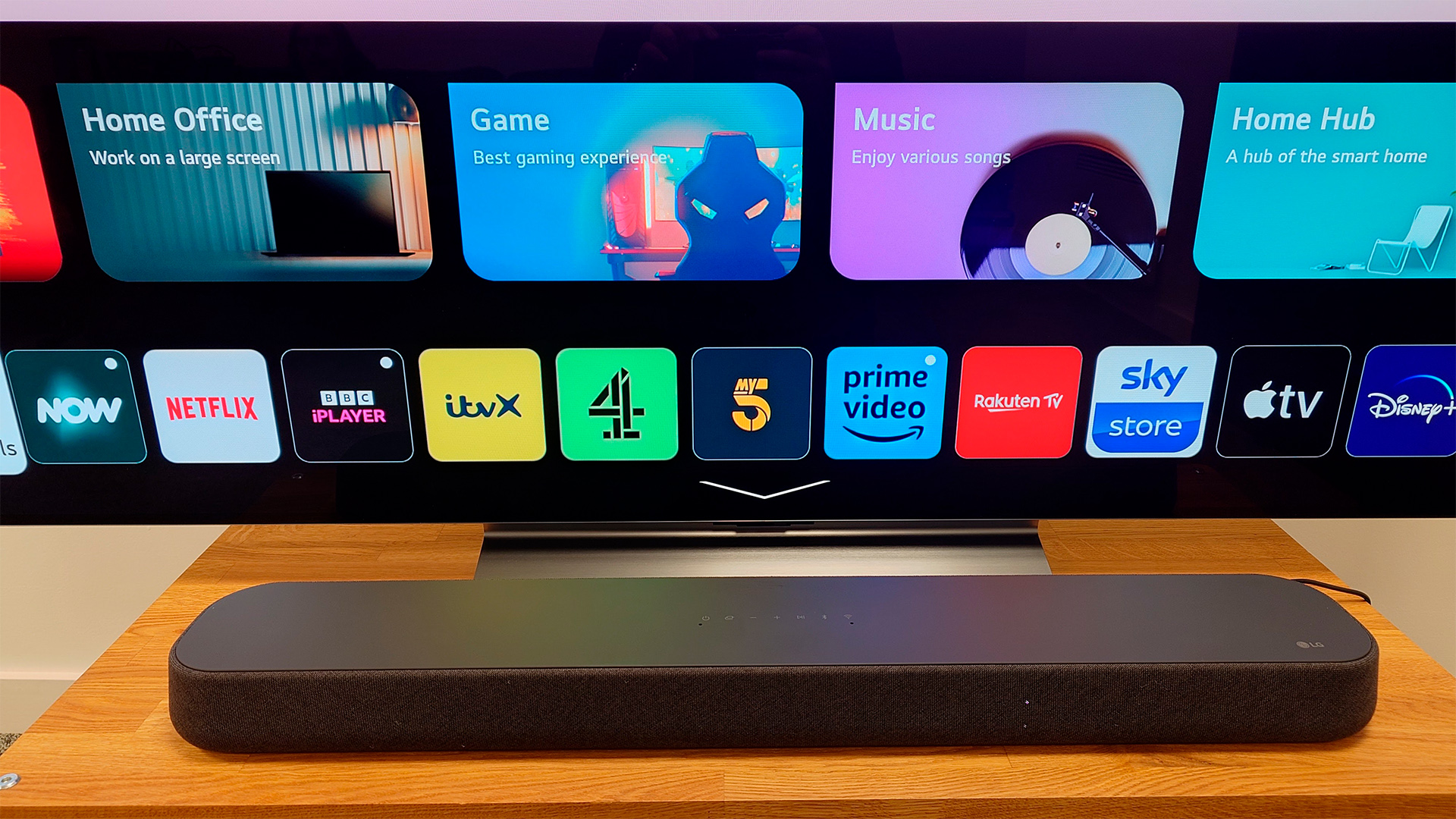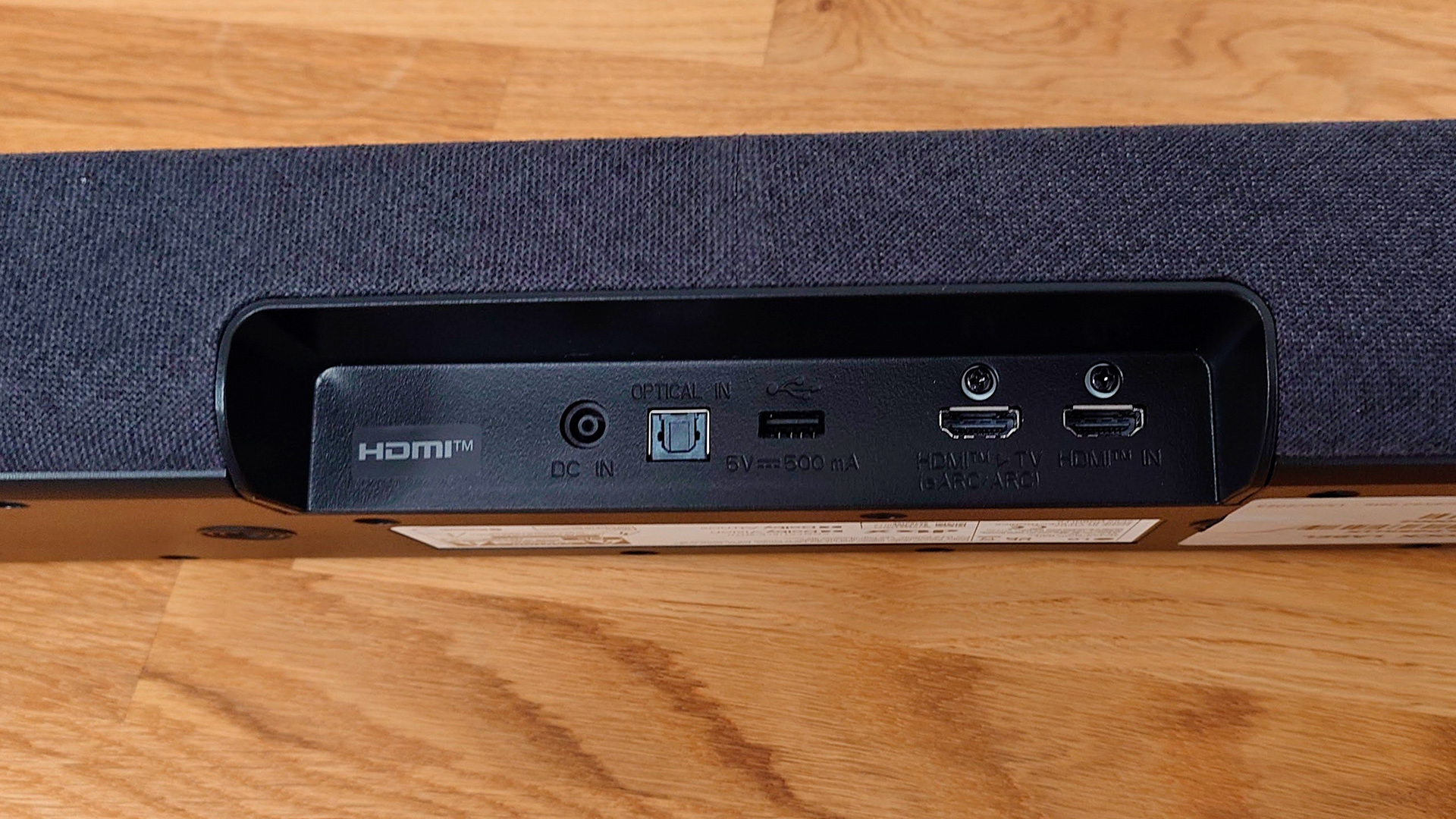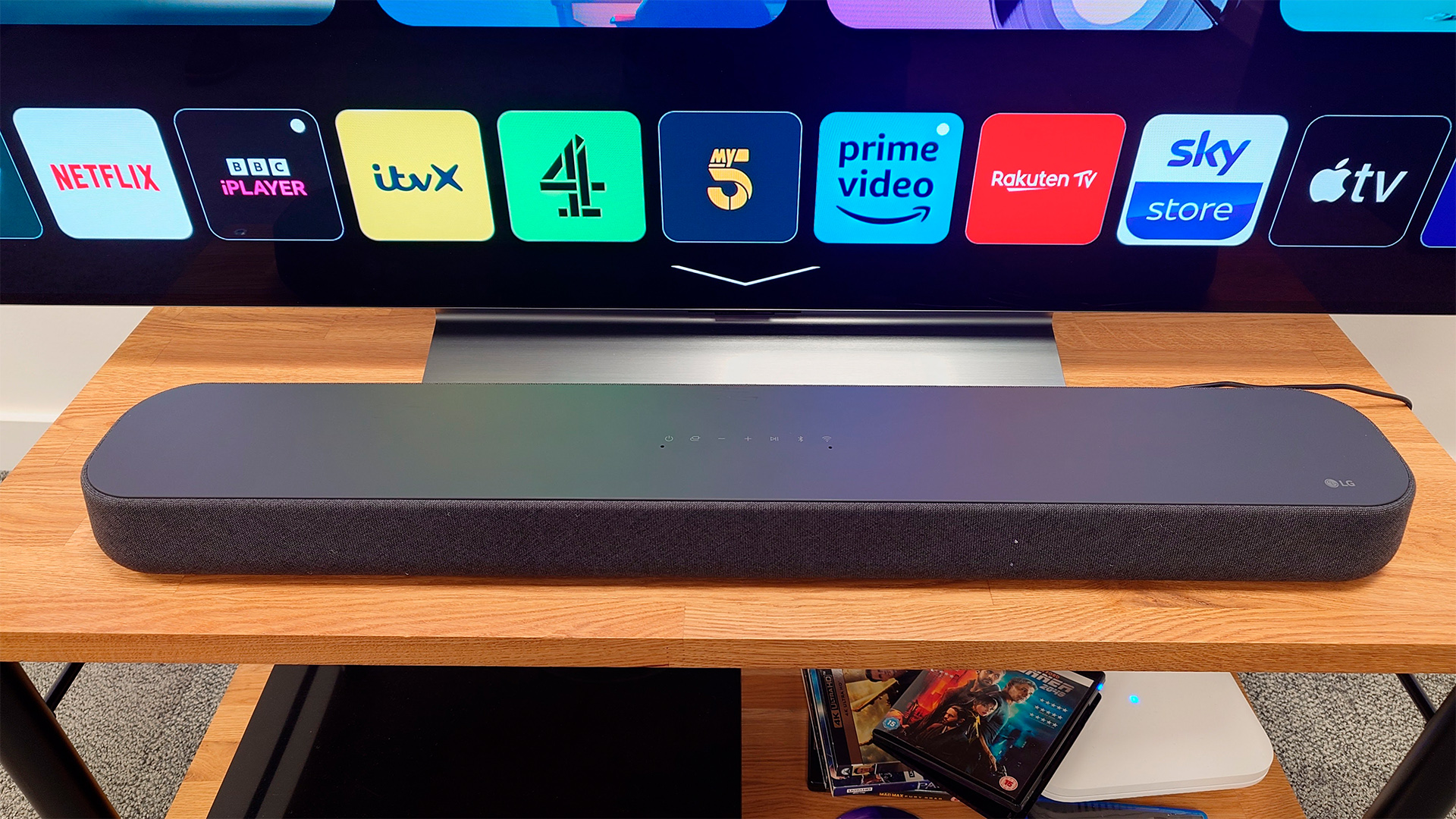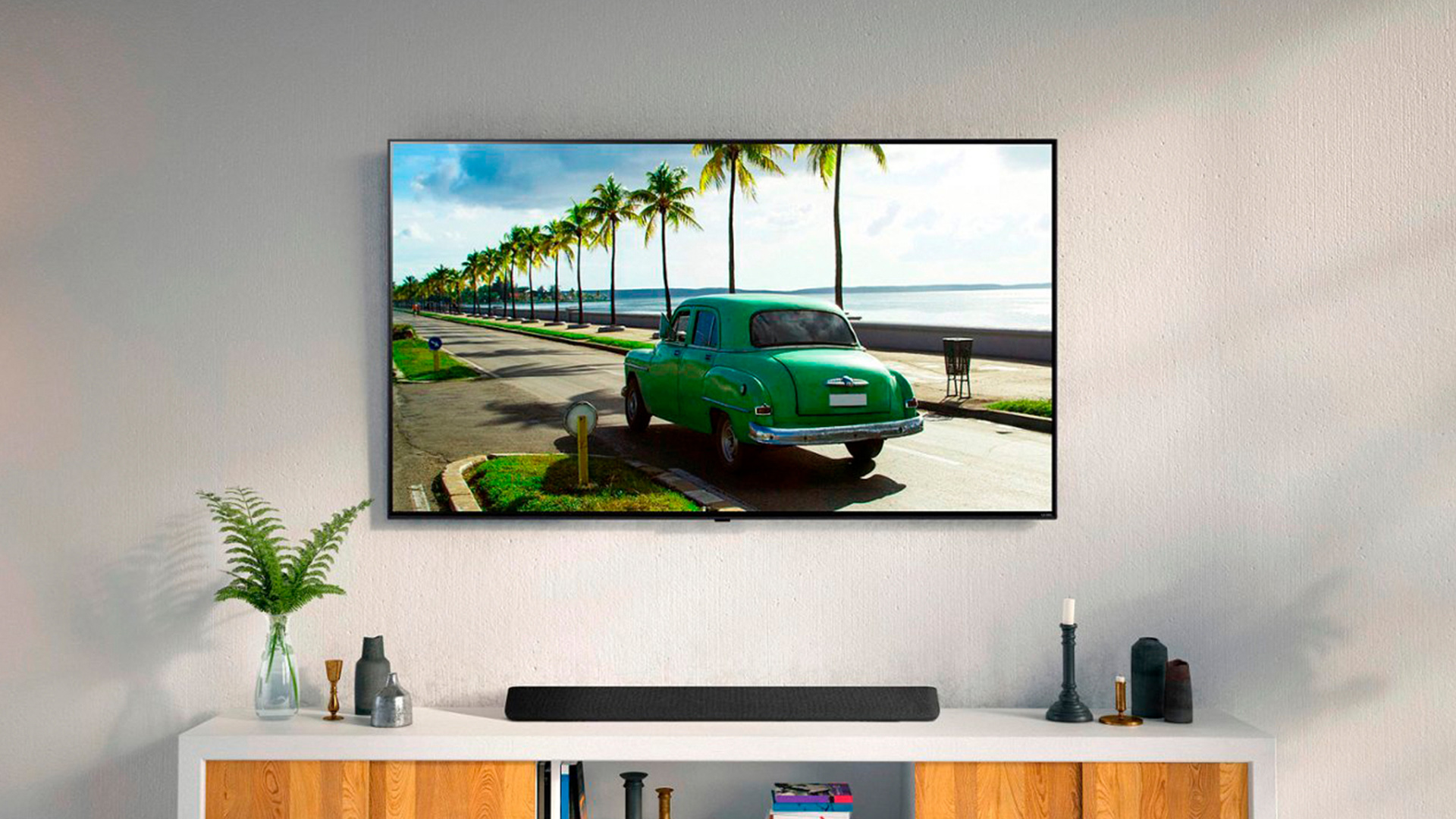What Hi-Fi? Verdict
Despite its admirable build and feature set, the USE6S’s sound is a long way short of the best in class
Pros
- +
4K/120Hz HDMI passthrough
- +
Excellent streaming compatibility
- +
Good clarity
Cons
- -
Poor dynamics
- -
Struggles musically
- -
Weak Atmos height presentation
Why you can trust What Hi-Fi?
Meet the LG USE6S, a plucky Atmos-equipped soundbar that’s positioned in the mid-range sector, offering spatial sound at a wallet-friendly price. However, don’t be fooled by its chipper first impressions, as it's harbouring a dark secret identity.
In some regions, this soundbar is known as the LG Eclair SE6, and if that choux pastry moniker sounds familiar, then you’ll join us in our predisposed scepticism. The last Eclair-branded Dolby Atmos soundbar from LG was a uniquely miniature bar paired with an equally oddly shaped subwoofer; and while it won some points for its compact design, its sound and connectivity didn’t win us over – and unfortunately, this isn’t a beauty contest.
Thankfully, LG has taken a more conventional approach with this soundbar, as it returns to a traditional form factor, ditches the gimmicky sub and includes much more in the way of connectivity. So has LG cracked the winning recipe for this sweet treat of a soundbar, or has it left us still hungry for more?
Price

The LG USE6S is priced at £500 (around AU$930), which puts it in the direct firing line of a couple of obvious Dolby Atmos soundbar rivals.
The first is the Sony HT-A3000, an Atmos-enabled soundbar that we reviewed very recently and that retails for £500.
Then there's the Sonos Beam (Gen 2), of course, which is a five-star soundbar through and through, with the Awards clout to back it up. It can be found for the same £500 asking price and is often reduced due to fairly frequent sales. The mere existence of the Sonos Beam is a nuisance for the Eclair, but we’ll dive deeper into this comparison later.
As for the rest of the LG soundbar lineup, we have tested the higher-end USC9S, which costs £999 / AU$1499 and is designed to be paired with the LG C3 OLED. However, the range extends even further with the flagship S95QR which retails for £1700 / AU$2000 and includes a subwoofer and surround speakers in the box.
The latest hi-fi, home cinema and tech news, reviews, buying advice and deals, direct to your inbox.
Build

The USE6S’s build is arguably its strongest attribute, as by soundbar standards it's quite a nice-looking and feeling unit. Its rounded, understated aesthetic that tapers upwards slightly is intentionally minimalist to blend seamlessly into any entertainment set-up. Measuring 6 x 80 x 13cm (h x w x d) and weighing 3.5kg, the USE6S is fairly low-key when compared to the aforementioned Sony, but the Sonos is still slightly more compact. That being said, the LG can still sit comfortably below most TVs without obstructing the screen.
The casework is made of a soft-touch plastic top plate and a mesh covering that surrounds the soundbar’s other edges. While the smooth plastic panel looks pleasing to the eye, it's also highly skilled at picking up fingerprints and even better at retaining them even after multiple polishes with a microfibre cloth. This, combined with the touch-sensitive buttons on the top panel, is a recipe for disaster. Thankfully, LG includes a remote control to adjust volume, input and settings, so you shouldn’t need to touch the bar itself with any regularity.
Speaking of the top panel of the soundbar, you’ll notice that there aren’t any speaker grilles as, despite this being a Dolby Atmos soundbar, there are no upward-firing drivers. LG has instead opted for the same approach as Sonos to achieve the Atmos height channels with HRTF (Head Related Transfer Function) used in lieu of dedicated up-firing speaker units. This psychoacoustic processing method tricks our brains into thinking that sound is coming from overhead.

Connectivity HDMI out (eARC), HDMI In (2.1), optical, USB, wi-fi, Bluetooth 5.0
Sound format support Dolby Atmos, DTS:X, PCM
Streaming Spotify Connect, Apple AirPlay 2, Chromecast, Tidal Connect
Voice control Google Assistant, Alexa
Dimensions (hwd) 6.3 x 80 x 13cm
Weight 3.5kg
In terms of physical speaker drivers, the USE6S has five drivers and four passive radiators to handle the lower frequencies and it uses these units in a 3.0 arrangement with a claimed total power output of 100W. LG says that the passive radiators let you experience full and consistent bass while keeping the interior components minimal and fuss-free.
One thing lacking from the LG’s build is a display. That's not uncommon in the soundbar world, but it's something that the Sony HT-A3000 does have. Instead, LG includes a trio of LEDs to indicate volume and what settings you’re adjusting, alongside a fairly loud narration of what you’re doing. It gets the job done, but we prefer the Sony HT-A3000’s small yet effective display, which makes navigating the system a bit easier.
Another aspect of the USE6S’s design that we’re fond of is the ease of connection. All of the available sockets are easily accessible, and the panel isn’t too recessed (unlike the Sony's), so hooking up an additional HDMI or attaching a particularly stiff cable is no bother.
Features

The LG USE6S’s feature set is a real mixed bag, as it has some very welcome additions and some that fail to impress. Starting off with the good stuff, the USE6S supports practically every sound format you could wish for, including Dolby Atmos, Dolby Digital, DTS:X and DTS: Digital Surround, as well as AAC and MQA.
Connectivity is also on point, with an HDMI eARC output and an HDMI 2.1 input that supports HDR10, 4K/120Hz passthrough, VRR and ALLM, although there are a few catches to be aware of here. When we hook up an Xbox Series X to this passthrough, everything is displayed correctly regarding resolution and refresh rate, although Dolby Vision gaming is restricted to 4K/60Hz. This isn’t an issue for PS5 users though as the console does not support Dolby Vision. The VRR feature is also limited to 4K/60Hz on the HDMI passthrough, which feels like an odd restriction.
Comparatively, neither the Sony HT-A3000 nor the Sonos Beam (Gen 2) feature HDMI passthrough sockets, so LG gets an extra point here as HDMI 2.1 connections are precious commodities. There is also a USB input for playing content directly from the bar and an optical input for an alternative method for hooking it up to your TV.
Wireless connectivity on the USE6S is also solid, with Bluetooth 5.0 (with the SBC and AAC codecs) and wi-fi on board. This allows you to stream to the bar via Spotify Connect, Apple AirPlay 2, Chromecast and Tidal Connect. You’ll have to rely on wi-fi though, as there is no ethernet connection for wired internet access. The USE6S is also compatible with Alexa and Google Assistant-enabled smart speakers, as although it doesn’t feature a built-in microphone, you can connect one of these smart speakers up in order to control the bar with your voice.
Now onto the features that don’t quite work as well. First up is the LG Sound Bar companion app, which is currently rated just 1.4 stars on the Apple App Store, and with good reason. You’ll need it to connect the soundbar to the internet and perform the room-tuning calibration, but just be warned that it’s not the smoothest experience by any means. The process of calibrating the bar is glitchy and unstable, and our first attempt fails miserably due to the process stopping midway through for no apparent reason. Closing the app and reopening it, we are met with a greyed-out option where the soundbar should be, saying it cannot connect – requiring us to reconnect to the soundbar from the very beginning. There are also plenty of grammatical errors and clunky user interface buttons to deal with, which just makes us think of all the times we’ve taken the Sonos S2 App for granted.
On to the aforementioned included remote, which is about as basic as a soundbar remote can be. It’s snappy and responsive in use, but its button selection is painfully basic. Most of what can be achieved on the remote can be done through the app, but considering the state of the app we’d rather avoid it when possible.
Thankfully, this is where the greater synergy between LG’s soundbars and TVs is evident, as there are a few exclusive features that become accessible through connecting the Eclair to a compatible LG TV. We have it hooked up to an LG C3 OLED, and it has the two headline features present: WOW Orchestra and WOW Interface. The former combines the TV’s built-in speaker with the soundbar’s drivers to create a harmonious sound between the devices. It's a clever use of the TV’s speakers, which would otherwise be inactive. However, it still feels slightly gimmicky and doesn’t exactly provide the “ultimate listening experience” that LG claims.
WOW Interface is slightly more useful as it brings up full on-screen controls for the soundbar and allows you to control it using your TV’s standard remote. This somewhat negates our prior gripe regarding the missing screen and is a much better alternative to the clumsy app. Here, you can switch between sound presets and adjust other settings, with the benefit of actually being able to see what you’re doing, but the catch is that you’ll need an LG TV to access this, otherwise you’re stuck with the app.
Sound

Despite making a fairly strong first impression with its build and feature set, the sound from the LG USE6S lets it down, putting it squarely behind its Sony and Sonos rivals. From the various sound modes, we end up sticking with the Cinema preset, as it appears to have the most impactful sound out of the bunch.
Starting with the opening of Unbroken in Dolby Atmos, we’re immediately met with a somewhat unbalanced display of dynamics, which is to say it handles some aspects better than others. As the B-24 bomber approaches, we’re presented with a lack of building tension. Instead, we’re subjected to a dull droning sound that never seems to amount to anything.
This doesn’t help the spatial effect either, as the sense of scale is diminished by the weak dynamics, as well as a lacklustre approach to height. We’ve established that this bar doesn’t have dedicated upward-firing drivers, but neither does the Sonos Beam (Gen 2) and yet their absence is felt much more on the LG. In comparison, the Beam feels much more immersive and features a wider sound field that takes greater advantage of the Atmos system.
That being said, low-level dynamics on the USE6S are actually quite good. Subtler details within the presentation can be appreciated thanks to this, including greater attention to the emotional inflexion of the soldier’s voices as the scene progresses. This extends to capturing detail within the less prominent sound effects, such as the mechanical clicks of switches, the whirring of the rotating gun turret or the creaking of the pilots’ leather gloves and jackets as they move around the cockpit. This adds a sense of nuance to the soundbar that isn’t always apparent in the larger-scale scenes.
The LG claws back some more integrity with its comprehensive handling of dialogue. Vocals are crisp and defined, and dialogue is brought further out of the mix than on the Sony HT-A3000, which makes the LG feel more articulate during scenes with lots of talking. This might make it a good soundbar for someone who simply wants the news and their daily soaps to be more distinguishable, and if that’s the case the LG USE6S might be for you.
Switching to The Batman for our trusty Batmobile car chase test scene (also in Dolby Atmos) we’re, unfortunately, exposed to further weaknesses of the LG soundbar. There is a lack of separation and spaciousness to the sound, which leads to an overall cluttered and claustrophobic performance, especially when it comes to sound effects. As The Penguin opens fire on the Batmobile, the sounds of the gunshots, the splintering glass and the cars’ engines all fight for dominance, creating a muddled and confusing overall sound.
The directionality of that sound is acceptable, though, as it moves with the cars on screen, and in brief moments we hear the bar attempt to step up the pace. But even with an exhilarating scene such as this, the soundbar’s flat and unengaging approach fails to excite or enhance the drama.
Finally testing out the Eclair’s musical ability, it's disappointing news once again. Streaming Bear’s Den’s Auld Wives via Tidal Connect, we find the soundbar struggles. Most notably, while the leading edges of bass notes are fairly precise, the soundbar loses grip after that and fails to define notes properly. There is little rhythmic energy and, in the end, it is all a bit uninspiring.
Verdict

It's a shame that the LG USE6S doesn’t sound better, as its feature set caters very well to gamers and those who want to stream music to it, and its clean aesthetics are appreciated. Unless you’re just after clearer dialogue, though, the Eclair isn’t a Dolby Atmos soundbar that we would recommend over its similarly-priced peers.
SCORES
- Sound 3
- Features 4
- Build 4
MORE:
Read our review of the Sonos Beam (Gen 2)
Also consider the Sonos Arc
Read our Sony HT-A3000 review
Best soundbars: top options for every budget, tried and tested
What Hi-Fi?, founded in 1976, is the world's leading independent guide to buying and owning hi-fi and home entertainment products. Our comprehensive tests help you buy the very best for your money, with our advice sections giving you step-by-step information on how to get even more from your music and movies. Everything is tested by our dedicated team of in-house reviewers in our custom-built test rooms in London, Reading and Bath. Our coveted five-star rating and Awards are recognised all over the world as the ultimate seal of approval, so you can buy with absolute confidence.

